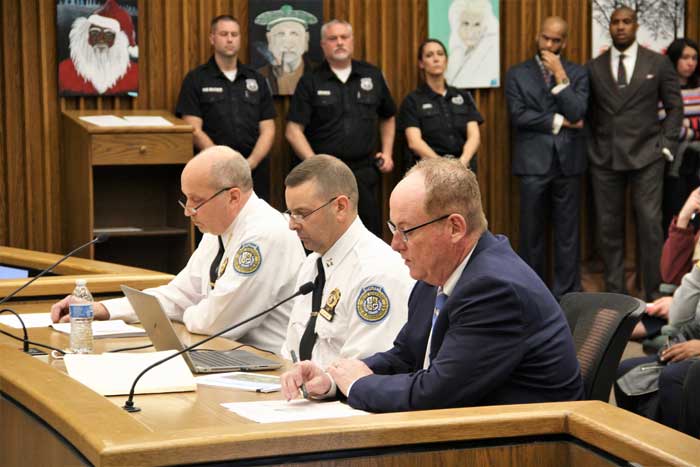POUGHKEEPSIE – A special meeting of the common council was held Monday night to hear the police department testify about policing, crime reduction, and police and community relations within the City of Poughkeepsie in light of a recent incident of alleged police brutality surrounding the arrest of two teenage sisters after an altercation.
With the exception of Council Member Randy Johnson III, all members were present. Council Chairwoman Ann Finney opened the meeting saying that no one in attendance would be allowed to speak about that incident out of the respect of privacy and due process because of the two teens now involved in a family court case.
Council chambers were “standing-room-only” causing a few in attendance to question why the meeting wasn’t held in a larger venue.
Mayor Robert Rolison opened the discussion recounting the origin and initiation of the city’s police retention plan designed to keep cops from transferring to other higher-paying departments. Since the plan was approved in July of 2018, the city has not lost one officer as a result of a transfer.
The mayor also spoke of attempts to diversify the department and said that since 2016, 20 percent of all new hires have been female which he claims to be well above the national average. The city has hired 30 new officers since 2016 out of a candidate pool of 86. “Those numbers speak to the challenges we have when it comes to attracting diversity.”
Police Chief Thomas Pape began his presentation to the council with the announcement that the “Civilian Complaint” form is now available on the city’s website and then transitioned into President Obama’s “Task Force on 21st Century Policing,” designed to strengthen community policing and trust among law enforcement and the community.
Pape said that the report has been hailed as a “road map of what police departments should be doing across the country.”
The Wallkill Town Police Department was the first in the Mid-Hudson Valley to embrace the former president’s 21st Century Policing initiative. Its chief, Robert Hertman, even lectured chiefs from across the country at the White House about the effort during the Obama Administration.
Lieutenant Sean McCarthy, the midnight watch commander, gave an overview, and update on the Procedural Justice program of which he is one of six Master instructors. McCarthy briefed the council on the program that teaches police officers to look at situations from different angles and treat every person in a way that they themselves wish to be treated.
The program, according to the lieutenant, is designed to “bring legitimacy back to law enforcement.” Every officer in the city has already received eight hours of training for the program.
Equipping police officers with body cameras has been a request by some members of both the common council and community and Chief Pape provided an update on the process. AXOM, maker of approximately 90 percent of the body cams used in the United States, has been chosen as the vendor for the city.
Pape said a few “trial” cameras are expected to arrive soon. Citing concern for budgeting, Pape said his department is “trying to be good stewards of taxpayer dollars” before announcing that the camera program was expected to cost $510,000 over five years and that additional recurring costs associated with the program would have to be budgeted for by the council. Councilmember Matthew McNamara was direct in his questioning, asking Pape “when can we expect to see body cams on the streets?” to which Pape responded, “my goal is the third quarter of 2019.”
Councilman Christopher Petsas noted that when he had served as council chairman, dash cameras were installed in some police vehicles but were removed two years later, without him knowing about it.
He advised Pape that he didn’t want a repeat of that with the body cams. Pape reiterated that the costs associated with the cameras are expensive and require a minimum five-year commitment.
“As long as I’m here, I am committed to staying with that product,” the chief said. Captain Wilson said “the older cameras were bought on a short order” and were used in three of the police SUVs. “That product was not the best on the market. We bought them within the confines of the budget we were provided. At a later time the hardware was no longer supported and the software had glitches so we had to abandon that program.” No final decision has been made on the plan to outfit patrol vehicles with dash cameras.








